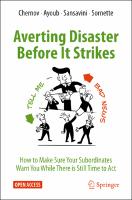Averting Disaster Before It Strikes
How to Make Sure Your Subordinates Warn You While There is Still Time to Act
Author(s)
Chernov, Dmitry
Ayoub, Ali
Sansavini, Giovanni
Sornette, Didier
Language
EnglishAbstract
Some of the major industrial disasters could have been prevented. When the facts of what happened are established, their stories share a common thread: before things spiralled out of control, there were workers at the affected sites who knew that the situation was dangerous, and could become catastrophic unless immediate action was taken. But tragically, nobody dared to tell the decision-makers who could have authorized that action. With no idea of the risks they were taking, the people in charge continued as normal… and disaster struck. Because vital information about risks could not flow freely from the shop floor to the director’s office, the crucial decisions were not made in time. This observation has been documented in the following major technological accidents: Challenger space shuttle explosion (USA, 1986); Chernobyl nuclear plant disaster (USSR, 1986); Deepwater Horizon oil spill (USA, 2010); Fukushima-1 nuclear power plant disaster (Japan, 2011); and numerous other industrial disasters. After accidents like these, losses and costs for dealing with the consequences are often hundreds — or even thousands — of times greater than the finances that would have been required to deal with the risks when they were first recognized. This handbook is about how to transform the way large critical infrastructure companies communicate about safety and technological risks. It aims to support senior managers to get the information they need from their subordinates concerning the risks they are facing, in order to prevent accidents before it is too late. The recommendations in this handbook are based on interviews with 100 executives at various levels, working in 65 critical infrastructure companies around the world, in power, oil and gas, metals, chemicals and petrochemicals, mining and other industries. The recommendations of these leaders were also tested in the pilot project, in an industrial company which is the world leader in its sector. More than 400 managers at various levels of the corporate hierarchy, and employees at several of the company’s industrial plants, took part in the project. This open access handbook is written for the owners, senior managers, and industrial safety directors of critical infrastructure companies.
Keywords
Business Philosophy and Environmental Safety; Risk Assessment and Management; Risk Information Concealment; Risk Communication and Decision-making; Risk Management PolicyDOI
10.1007/978-3-031-30772-0ISBN
9783031307720, 9783031307713, 9783031307720Publisher
Springer NaturePublisher website
https://www.springernature.com/gp/products/booksPublication date and place
Cham, 2023Grantor
Imprint
Springer International PublishingClassification
Management and management techniques
Occupational and industrial psychology
Security and fire alarm systems
Robotics


 Download
Download Web Shop
Web Shop